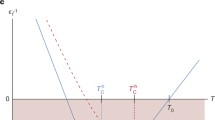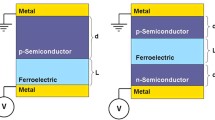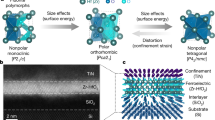Abstract
The demand for new materials to be used in field-effect transistors and similar devices with low energy loss is more than ever before as integrated circuits have become a considerable source of energy consumption. One of the challenges in designing such energy efficient logic devices is finding suitable dielectric materials systems for the gate that controls the drain current in a p-type channel. A fundamental limit for energy efficiency exists in such devices imposed by the polarizability of conventional linear gate dielectrics. Generating on/off states in the channel that differ by at least a million times in the magnitude of the drain current near saturation requires several volts of gate bias for the case of a linear dielectric material in a submicron device. In this study, we demonstrate that ferroelectric–paraelectric superlattice heterostructures can generate the same effect in a p-type channel for bias voltages much lower than in a linear high dielectric constant gate. We consider a metal/superlattice/p-type semiconductor stack for this purpose. Using a thermodynamic model, we show that the multi-domain state of the ferroelectric layers can be tailored and distinct on/off states of the channel are possible for gate bias voltages below 1 V. The origins of such functionality of ferroelectric–paraelectric superlattices are discussed with respect to material characteristics such as the phase transition temperature of the ferroelectric, total polarization, and the dielectric response.









Similar content being viewed by others
References
Gruverman A, Wu D, Lu H, Wang Y, Jang HW, Folkman CM, Zhuravlev MY, Felker D, Rzchowki M, Eom CB, Tsymbal EY (2009) Tunneling electroresistance effect in ferroelectric tunnel junctions at the nanoscale. Nano Lett 9:3539–3543
Tsymbal EY, Gruverman A (2013) Ferroelectric tunnel junctions: beyond the barrier. Nat Mater 12:602–604
Lu H, Lipatov A, Ryu S, Kim DJ, Lee H, Zhuravlev MY, Eom CB, Tsymbal EY, Sinitski A, Gruverman A (2014) Ferroelectric tunnel junctions with graphene electrodes. Nature 5:1–7
Watanabe Y (1995) Epitaxial all-perovskite ferroelectric field effect transistor with a memory retention. Appl Phys Lett 66:1770–1772
Mathews S, Ramesh R, Venkatesan T, Benedetto J (1997) Ferroelectric field effect transistor based on epitaxial perovskite heterostructures. Science 276:238–240
Ma TP, Han J (2002) Why is nonvolatile ferroelectric memory field-effect transistor still elusive? IEEE Electron Device Lett 23:386–388
Hoffman J, Pan X, Reiner JW, Walker FJ, Han JP, Ahn CH, Ma TP (2010) Ferroelectric field effect transistors for memory applications. Adv Mater 22:2957–2961
Van Hai L, Takahashi M, Sakai S (2010) Fabrication and characterization of sub-0.6-µm ferroelectric-gate field-effect transistors. Semicond Sci Technol 25:115013
Salvatore GA, Lattanzio L, Bouvet D, Ionescu AM (2011) Modeling the temperature dependence of Fe-FET static characteristics based on Landau’s theory. IEEE Trans Electron Devices 58:3162–3169
Salvatore GA, Lattanzio L, Bouvet D, Stolichnov I, Setter N, Ionescu AM (2010) Ferroelectric transistors with improved characteristics at high temperature. Appl Phys Lett 97:053503
Jiang B, Tang M, Li J, Xiao Y, Tang Z, Cai H, Lv X, Zhou Y (2012) Large memory window and good retention characteristics of ferroelectric-gate field-effect transistor with Pt/Bi3.4Ce0.6Ti3O12/CeO2/Si structure. J Phys D 45:025102
Tanakamaru S, Hatanaka T, Yajima R, Takahaski M, Shigeki S, Takeuchi K (2009) A 0.5 V operation, 32 % lower active power, 42 % lower leakage current, ferroelectric 6T-SRAM with VTH self-adjusting function for 60 % larger static noise margin. In: IEEE international on electron devices meeting, IEDM, pp 283–286
Horiuchi T, Takahashi M, Li Q-H, Wang S, Sakai S (2010) Lowered operation voltage in Pt/SBi2Ta2O9/HfO2/Si ferroelectric-gate field-effect transistors by oxynitriding Si. Semicond Sci Technol 25:055005
Misirlioglu IB, Vasiliev AL, Aindow M, Alpay SP, Ramesh R (2004) Threading dislocation generation in epitaxial (Ba, Sr) TiO3 films grown on (001) LaAlO3 by pulsed laser deposition. Appl Phys Lett 84:1742–1744
Sharma A, Ban ZG, Alpay SP, Mantese JV (2004) Effect of operating temperature and film thickness on the pyroelectric response of ferroelectric materials. Appl Phys Lett 84:4959–4961
Okatan MB, Mantese JV, Alpay SP (2010) Effect of space charge on the polarization hysteresis characteristics of monolithic and compositionally graded ferroelectrics. Acta Mater 58:39–48
Okatan MB, Mantese J, Alpay S (2009) Polarization coupling in ferroelectric multilayers. Phys Rev B 79:174113
Eliseev EA, Morozovska AN (2009) General approach for the description of size effects in ferroelectric nanosystems. J Mater Sci 44:5149–5160. doi:10.1007/s10853-009-3473-0
Tenne DA, Soukiassian A, Xi XX, Taylor TR, Hansen PJ, Speck JS, York RA (2004) Effect of thermal strain on the ferroelectric phase transition in polycrystalline Ba0.5Sr0.5TiO3 thin films studied by Raman spectroscopy. Appl Phys Lett 85:4124–4126
Haeni JH, Irvin P, Chang W, Uecker R, Reiche P, Li YL, Choudhury S, Tian W, Hawley ME, Craigo B, Tagantsev AK, Pan XQ, Streiffer SK, Chen LQ, Kirchoefer SW, Levy J, Schlom DG (2004) Room-temperature ferroelectricity in strained SrTiO3. Nature 430:583–586
Misirlioglu IB, Vasiliev AL, Alpay SP, Aindow M, Ramesh R (2006) Defect microstructures in epitaxial PbZr0.2Ti0.8O3 films grown on (001) SrTiO3 by pulsed laser deposition. J Mater Sci 41:697–707. doi:10.1007/s10853-006-6488-9
Weiss CV, Okatan MB, Alpay SP, Cole MW, Ngo E, Toonen RC (2009) Compositionally graded ferroelectric multilayers for frequency agile tunable devices. J Mater Sci 44:5364–5374. doi:10.1007/s10853-009-3514-8
Han H, Lee K, Lee W, Alexe M, Hesse D, Baik S (2009) Fabrication of epitaxial nanostructured ferroelectrics and investigation of their domain structures. J Mater Sci 44:5167–5181. doi:10.1007/s10853-009-3528-2
Arredondo M, Saunders M, Petraru A, Kohlstedt H, Vrejoiu I, Alexe M, Browning ND, Munroe P, Nagarajan V (2009) Structural defects and local chemistry across ferroelectric-electrode interfaces in epitaxial heterostructures. J Mater Sci 44:5297–5306. doi:10.1007/s10853-009-3548-y
Lin Y, Chen CL (2009) Interface effects on highly epitaxial ferroelectric thin films. J Mater Sci 44:5274–5287. doi:10.1007/s10853-009-3664-8
Morioka H, Saito K, Yokoyama S, Oikawa T, Kurosawa T, Funakubo H (2009) Effect of film thickness on ferroelectric domain structure and properties of Pb(Zr0.35Ti0.65)O3/SrRuO3/SrTiO3 heterostructures. J Mater Sci 44:5318–5324. doi:10.1007/s10853-009-3606-5
Schlom DG, Chen LQ, Eom CB, Rabe KM, Streiffer SK, Triscone JM (2007) Strain tuning of ferroelectric thin films. Annu Rev Mater Res 37:589–626
Choi KJ, Biegalski M, Li YL, Sharan A, Schubert J, Uecker R, Reiche P, Chen YB, Pan XQ, Gopalan V, Chen LQ, Schlom DG, Eom CB (2004) Enhancement of ferroelectricity in strained BaTiO3 thin films. Science 306:1005–1009
Sun F, Khassaf H, Alpay SP (2014) Strain engineering of piezoelectric properties of strontium titanate thin films. J Mater Sci 49:5978–5985. doi:10.1007/s10853-014-8316-y
Janolin PE (2009) Strain on ferroelectric thin films: example of Pb(Zr1−x Ti x )O3. J Mater Sci 44:5025–5048. doi:10.1007/s10853-014-8316-y
Davis L, Rubin LG (1953) Some dielectric properties of barium-strontium titanate ceramics at 3000 megacycles. J Appl Phys 24:1194–1197
Haun MJ, Zhuang ZQ, Furman E, Jang SJ, Cross LE (1989) Thermodynamic theory of the lead zirconate-titanate solid solution system, part III : curie constant and sixth-order polarization interaction dielectric stiffness coefficients. Ferroelectrics 99:45–54
Soukiassian A, Tian W, Vaithyanathan V, Haeni JH, Chen LQ, Xi XX, Schlom DG, Tenne DA, Sun HP, Pan XQ, Choi KJ, Eom CB, Li YL, Jia QX, Constantion C, Feenstra RM, Bernhagen M, Reiche P, Uecker R (2008) Growth of nanoscale BaTiO3/SrTiO3 superlattices by molecular-beam epitaxy. J Mater Res 23:1417–1432
Specht E, Christen H-M, Norton D, Boatner L (1998) X-Ray diffraction measurement of the effect of layer thickness on the ferroelectric transition in epitaxial KTaO3/KNbO3 multilayers. Phys Rev Lett 80:4317–4320
Nakagawara O, Shimuta T, Makino T, Arai S, Tabata H, Kawai T (2002) Dependence of dielectric and ferroelectric behaviors on growth orientation in epitaxial BaTiO3/SrTiO3 superlattices. Vacuum 66:397–401
Kim L, Jung D, Kim J, Kim YS, Lee J (2003) Strain manipulation in BaTiO3/SrTiO3 artificial lattice toward high dielectric constant and its nonlinearity. Appl Phys Lett 82:2118–2120
Corbett MH, Bowman RM, Gregg JM, Foord DT (2001) Enhancement of dielectric constant and associated coupling of polarization behavior in thin film relaxor superlattices. Appl Phys Lett 79:815–817
Tabata H, Tanaka H, Kawai T (1994) Formation of artificial BaTiO3/SrTiO3 superlattices using pulsed laser deposition and their dielectric properties. Appl Phys Lett 65:1970–1972
Zubko P, Stucki N, Lichtensteiger C, Triscone J-M (2010) X-Ray diffraction studies of 180° ferroelectric domains in PbTiO3/SrTiO3 superlattices under an applied electric field. Phys Rev Lett 104:187601
Roytburd AL, Zhong S, Alpay SP (2005) Dielectric anomaly due to electrostatic coupling in ferroelectric-paraelectric bilayers and multilayers. Appl Phys Lett 87:092902
Okatan MB, Misirlioglu IB, Alpay SP (2010) Contribution of space charges to the polarization of ferroelectric superlattices and its effect on dielectric properties. Phys Rev B 82:094115
Tsurumi T, Harigai T, Tanaka D, Kakemoto H, Wada S (2004) Anomalous dielectric and optical properties in perovskite-type artificial superlattices. Sci Technol Adv Mater 5:425–429
Tsurumi T, Ichikawa T, Harigai T, Kakemoto H, Wada S (2002) Dielectric and optical properties of BaTiO3/SrTiO3 and BaTiO3/BaZrO3 superlattices. J Appl Phys 91:2284–2289
Neaton JB, Rabe KM (2003) Theory of polarization enhancement in epitaxial BaTiO3/SrTiO3 superlattices. Appl Phys Lett 82:1586–1588
Aguado-Puente P, García-Fernández P, Junquera J (2011) Interplay of couplings between antiferrodistortive, ferroelectric, and strain degrees of freedom in monodomain PbTiO3/SrTiO3 superlattices. Phys Rev Lett 107:217601
Zubko P, Jecklin N, Torres-Pardo A, Aguado-Puente P, Gloter A, Lichtensteiger C, Junquera J, Stephan O, Triscone J-M (2012) Electrostatic coupling and local structural distortions at interfaces in ferroelectric/paraelectric superlattices. Nano Lett 12:2846–2851
Misirlioglu IB, Kesim MT, Alpay SP (2014) Layer thickness and period as design parameters to tailor pyroelectric properties in ferroelectric superlattices. Appl Phys Lett 105:172905
Kumar A, Katiyar RS, Premnath RN, Rinaldi C, Scott JF (2009) Strain-induced artificial multiferroicity in Pb(Zr0.53Ti 0.47)O3/Pb(Fe0.66W0.33)O3 layered nanostructure at ambient temperature. J Mater Sci 44:5113–5119. doi:10.1007/s10853-009-3503-y
Tsurumi T, Miyasou T, Ishibashi Y, Ohashi N (1998) Preparation and dielectric property of BaTiO3–SrTiO3 artificially modulated structures. Jpn J Appl Phys 37:5104–5107
Tsurumi T, Suzuki T, Yamane M, Daimon M (1994) Fabrication of barium titanate/strontium titanate artificial superlattice by atomic layer epitaxy. Jpn J Appl Phys 33:5192–5195
Tsurumi T, Harigai T, Tanaka D, Nam S-M, Kakemoto H, Wada S, Saito K (2004) Artificial ferroelectricity in perovskite superlattices. Appl Phys Lett 85:5016
Neaton JB, Rabe KM (2003) Theory of polarization enhancement in epitaxial BaTiO3/SrTiO3 superlattices. Appl Phys Lett 82:1586–1588
Stephenson GB, Elder KR (2006) Theory for equilibrium 180° stripe domains in PbTiO3 films. J Appl Phys 100:051601
Specht ED, Christen H-M, Norton DP, Boatner LA (1998) X-Ray diffraction measurement of the effect of layer thickness on the ferroelectric transition in epitaxial KTaO3/KNbO3 multilayers. Phys Rev Lett 80:4317–4320
Jo JY, Chen P, Sichel RJ, Callori SJ, Sinsheimer J, Dufresne EM, Dawber M, Evans PG (2011) Nanosecond dynamics of ferroelectric/dielectric superlattices. Phys Rev Lett 107:055501
Levy P, Zhang S, Fert A (1990) Electrical conductivity of magnetic multilayered structures. Phys Rev Lett 65:1643–1646
Kesim MT, Cole MW, Zhang J, Misirlioglu IB, Alpay SP (2014) Tailoring dielectric properties of ferroelectric-dielectric multilayers. Appl Phys Lett 104:022901
Haun MJ, Furman E, McKinstry HA, Cross LE (1989) Thermodynamic theory of the lead zirconate-titanate solid solution system, part II: tricritical behavior. Ferroelectrics 99:27–44
Pertsev NA, Kukhar V, Kohlstedt H, Waser R (2003) Phase diagrams and physical properties of single-domain epitaxial Pb(Zr1−x Ti x )O3 thin films. Phys Rev B 67:054107
Pertsev NA, Tagantsev AK, Setter N (2000) Phase transitions and strain-induced ferroelectricity in SrTiO3 epitaxial thin films. Phys Rev B 61:R825–R829
Hlinka J, Márton P (2006) Phenomenological model of a 90° domain wall in BaTiO3-type ferroelectrics. Phys Rev B 74:104104
Tagantsev AK (2008) Landau expansion for ferroelectrics: which variable to use? Ferroelectrics 375:19–27
Bratkovsky AM, Levanyuk AP (2009) Continuous theory of ferroelectric states in ultrathin films with real electrodes. J Comput Theor Nanos 6:465–489
Stephanovich VA, Luk’yanchuk IA, Karkut MG (2005) Domain-enhanced interlayer coupling in ferroelectric/paraelectric superlattices. Phys Rev Lett 94:047601
Christen H-M, Specht ED, Norton DP, Chisholm MF, Boatner LA (1998) Long-range ferroelectric interactions in KTaO3/KNbO3 superlattice structures. Appl Phys Lett 72:2535–2537
Levanyuk AP, Misirlioglu IB (2011) Phase transitions in ferroelectric-paraelectric superlattices. J Appl Phys 110:114109
Jain M, Majumder S, Guo R, Bhalla AS, Katiyar RS (2002) Synthesis and characterization of lead strontium titanate thin films by sol–gel technique. Mater Lett 56:692–697
Lee SW, Kwon OS, Han JH, Hwang CS (2008) Enhanced electrical properties of SrTiO3 thin films grown by atomic layer deposition at high temperature for dynamic random access memory applications. Appl Phys Lett 92:222903
Misirlioglu IB, Kesim MT, Alpay SP (2014) Strong dependence of dielectric properties on electrical boundary conditions and interfaces in ferroelectric superlattices. Appl Phys Lett 104:022906
Sakai S, Takahashi M (2010) Recent progress of Ferroelectric-Gate Field-Effect transistors and applications to nonvolatile logic and FeNAND flash memory. Materials 3:4950–4964
Kandaswamy PK, Guillot F, Bellet-Amalric E, Monroy E, Nevou L, Tchernycheva M, Michon A, Julien FH, Baumann E, Giorgetta FR, Hofstetter D, Remmele T, Albrecht M, Birner S, Dang LS (2008) GaN/AlN short-period superlattices for intersubband optoelectronics: a systematic study of their epitaxial growth, design, and performance. J Appl Phys 104:093501
Dong L, Alpay SP (2012) Role of heteroepitaxial misfit strains on the band offsets of Zn1-xBexO/ZnO quantum wells: a first-principles analysis. J Appl Phys 111:113714
Dong L, Mantese JV, Avrutin V, Ozgur U, Morkoc H, Alpay SP (2013) Strain induced variations in band offsets and built-in electric fields in InGaN/GaN multiple quantum wells. J Appl Phys 114:043715
Li YL, Hu SY, Tenne D, Soukiassian A, Schlom DG, Xi XX, Choi KJ, Eom CB, Saxena A, Lookman T, Jia QX, Chen LQ (2007) Prediction of ferroelectricity in BaTiO3/SrTiO3 superlattices with domains. Appl Phys Lett 91:112914
National Research Council (2008) Integrated computational materials engineering: a transformational discipline for improved competitiveness and national security. The National Academies Press, Washington, DC
Acknowledgements
The authors gratefully acknowledge many discussions with Dr. J. V. Mantese (United Technologies Research Center, East Hartford, CT—USA). M. T. Kesim is supported by a GE Graduate Fellowship.
Author information
Authors and Affiliations
Corresponding author
Ethics declarations
Conflict of interest
The authors declare that they have no conflict of interest.
Rights and permissions
About this article
Cite this article
Misirlioglu, I.B., Sen, C., Kesim, M.T. et al. Low-voltage ferroelectric–paraelectric superlattices as gate materials for field-effect transistors. J Mater Sci 51, 487–498 (2016). https://doi.org/10.1007/s10853-015-9301-9
Received:
Accepted:
Published:
Issue Date:
DOI: https://doi.org/10.1007/s10853-015-9301-9




